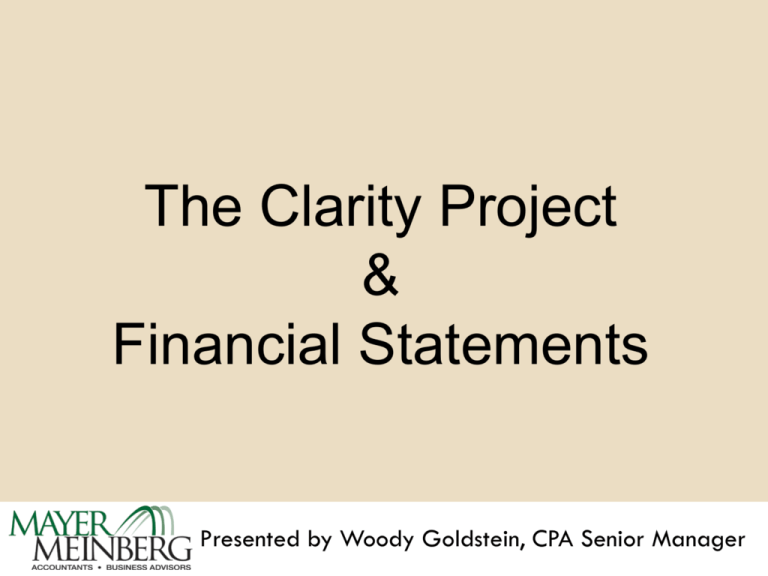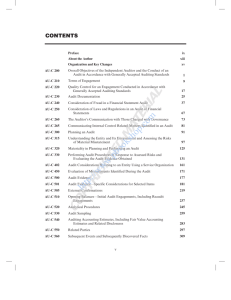Clarity Standards
advertisement

The Clarity Project & Financial Statements J Presented by Woody Goldstein, CPA Senior Manager Standard Setters for CPAs To Name a few: FASB – Financial Accounting Standards Board ASB – Accounting Standards Board PCAOB – Public Company Accounting Oversight Board Clarity Project Goals Address concerns over length and complexity of standards Make standards easier to read, understand & implement Lead to enhancements in audit quality Converge with International Standards on Auditing ASB- Clarity Project Effective for years ending on and after: December 15, 2011- Public Companies December 15, 2012 – Non Public Companies Main Purposes: Codifies to one document to make it easier to apply Converges with International Standards on Auditing What has changed? Auditors' Reports Terminology in Financial Statements Engagement Letters Overview of Substantive Changes to the Standards Audit Report Although the report is substantively unchanged in content, the new format is very different. The standard report is now six paragraphs instead of three. It is required to use headings to identify the content of the different sections of the standard report and any additional paragraphs. Forming an Opinion & Reporting (AU-C 700) One requirement to note Report uses standard language to describe management's responsibility for the: Preparation of financial statements, and Design, implementationand maintenance of relevant internal controls Prohibits elaboration in auditor's report about management's responsibility (or reference to another document that does so) Modifications to the Opinion (AU-C 705) Basis for qualified, adverse, or disclaimer (placed before opinion paragraph) Modified opinion (Qualified, Adverse, or Disclaimer) Auditor Report: Prior to 12-15-2012 Independent Auditors’ Report To the Board of Directors and Stockholders of Sample Owners Corp.: We have audited the accompanying balance sheets of Sample Owners Corp. (a Cooperative Housing Corporation) as of December 31, 2011 and 2010, and the related statements of operations and accumulated deficit and cash flows for the years then ended. These financial statements are the responsibility of the Corporation's management. Our responsibility is to express an opinion on these financial statements based on our audits. We conducted our audits in accordance with U.S. generally accepted auditing standards. Those standards require that we plan and perform the audits to obtain reasonable assurance about whether the financial statements are free of material misstatement. An audit includes examining, on a test basis, evidence supporting the amounts and disclosures in the financial statements. An audit also includes assessing the accounting principles used and significant estimates made by management, as well as evaluating the overall financial statement presentation. We believe that our audits provide a reasonable basis for our opinion. In our opinion, the financial statements referred to above present fairly, in all material respects, the financial position of Sample Owners Corp. as of December 31, 2011 and 2010, and the results of its operations and its cash flows for the years then ended in conformity with U.S. generally accepted accounting principles. Management has omitted the information about the estimates of future costs of major repairs and replacements that U.S. generally accepted accounting principles require to be presented to supplement the basic financial statements. Such missing information, although not a part of the basic financial statements, is required by the Financial Accounting Standards Board, who considers it to be an essential part of financial reporting for placing the basic financial statements in an appropriate operational, economic, or historical context. Our opinion on the basic financial statements is not affected by the missing information. CPA Firm Signature Auditor Report: Clarity After 12-15-2012 Independent Auditors’ Report To the Board of Directors and Stockholders of Sample Owners Corp.: We have audited the accompanying financial statements of Sample Owners Corp. (a Cooperative Housing Corporation), which comprise the balance sheets as of December 31, 2012 and 2011, and the related statements of operations and accumulated deficit and cash flows for the years then ended, and the related notes to the financial statements. Management’s Responsibility for the Financial Statements Management is responsible for the preparation and fair presentation of these financial statements in accordance with accounting principles generally accepted in the United States of America; this includes the design, implementation, and maintenance of internal control relevant to the preparation and fair presentation of financial statements that are free from material misstatement, whether due to fraud or error. Auditors’ Responsibility Our responsibility is to express an opinion on these financial statements based on our audits. We conducted our audits in accordance with auditing standards generally accepted in the United States of America. Those standards require that we plan and perform the audits to obtain reasonable assurance about whether the financial statements are free from material misstatement. An audit involves performing procedures to obtain audit evidence about the amounts and disclosures in the financial statements. The procedures selected depend on the auditor’s judgment, including the assessment of the risks of material misstatement of the financial statements, whether due to fraud or error. In making those risk assessments, the auditor considers internal control relevant to the entity’s preparation and fair presentation of the financial statements in order to design audit procedures that are appropriate in the circumstances, but not for the purpose of expressing an opinion on the effectiveness of the entity’s internal control. Accordingly, we express no such opinion. An audit also includes evaluating the appropriateness of accounting policies used and the reasonableness of significant accounting estimates made by management, as well as evaluating the overall presentation of the financial statements. We believe that the audit evidence we have obtained is sufficient and appropriate to provide a basis for our audit opinion. Opinion In our opinion, the financial statements referred to above present fairly, in all material respects, the financial position of Sample Owners Corp. as of December 31, 2012 and 2011, and the results of its operations and its cash flows for the years then ended in conformity with accounting principles generally accepted in the United States of America. Auditor Report: Clarity After 12-15-2012 Page 2 Other Matter Sample Owners Corp. has omitted the information about the estimates of future costs of major repairs and replacements that accounting principles generally accepted in the United States of America require to be presented to supplement the basic financial statements. Such missing information, although not a part of the basic financial statements, is required by the Financial Accounting Standards Board, who considers it to be an essential part of financial reporting for placing the basic financial statements in an appropriate operational, economic, or historical context. Our opinion on the basic financial statements is not affected by such missing information. CPA Firm Signature Auditor’s Report - New 1st Paragraph – Describes the financial statements that were audited 2nd Paragraph - Sets forth management’s responsibility for the financial Statements 3rd Paragraph - Auditor’s responsibility to express an opinion on the financial statements based on the audit 4th Paragraph - Overview of audit procedures 5th Paragraph - Statement by auditor that the audit is sufficient to provide a basis for opinion 6th Paragraph - Auditor’s opinion Emphasis of Matter & Other Matter Paragraphs (AU-C 706) Emphasis of Matter Matters appropriately presented or disclosed Other Matter To understand audit matters (combining statements, Supplementary Information, Required Supplementary Information) New Terms – Continued Old term: Emphasis-of-a-matter paragraph New term: Emphasis-of-matter paragraph or other-matter paragraph The concept of an additional paragraph that does not affect the opinion has been retained, but the name of the paragraph depends on its content: if it relates to something appearing in or disclosed in the financial statements, it is an emphasis-of-matter paragraph; if it relates to the audit, it is an other-matter paragraph. Emphasis of Matter & other Matter Paragraphs (AU-C 706) Emphasis of Matter Other Matter Going concern Audit reports of prior periods presented Contractual or regulatory reporting frameworks Materially inconsistent "other information" Consistency "In relation to" opinion Litigation uncertainty RSI (required supplementary information) Major catastrophe General use regulatory F/S Significant related parties "In connection with" compliance reporting Subsequent events “Other supplementary information New Terms Old term: GAAP New term Applicable financial reporting framework The new standards are not GAAP-centric; they are written to apply GAAP and other bases of accounting. References to GAAP have been replaced with reference to the financial reporting framework, and discussions of the effects of the application of GAAP have been replaced with generic discussions. New Terms – Continued Old Term: OCBOA New Term: Special purpose framework A special purpose framework is difference from a fair presentation framework, such as GAAP. The standard notes that OCBOA is a term commonly used to refer to some special purpose presentations, but does not use that term again. New Terms – Continued Old term: Financial statements containing components such as consolidated or combined financial statements, principal auditor, other auditor New term: Group financial statements, group audit team, group engagement partner, component auditor. (The dividedresponsibility report, itself still refers to the component auditor as an other auditor, however.) Overview of Substantive Changes to the Standards Financial Reporting Framework The clarified standards assume a more principles based perspective than their predecessors. There is no longer a presumption that GAAP provides the basis of accounting underlying the financial statements, which makes it easier to apply the standards in a non-GAAP environment. Overview of Substantive Changes to the Standards Fair Presentation Historically, the standards never used the term fair presentation or fairly present unless it was modified to refer to the criteria used such as "in conformity with GAAP.“ The clarified standards, in contrast, use the term on its own and say that mere conformity with GAAP, or another framework, does not necessarily mean the financial statements are fairly presented. Special Considerations - Special Purpose Frameworks (AU-C 800) Replaces OCBOA with cash, tax, contractual and regulatory Requires the auditor to understand the purpose and intended users for framework appropriateness Audit still based on the rest of GAAS, but this section provides the reporting requirements and guidance. Multi-Employer Pension Plan Disclosures The FASB now requires employers that participate in multi-employer pension plans to provide additional quantitative and qualitative disclosures. Enhanced disclosures are designed to assist financial statement users in assessing the potential impact of an entity’s participation in plan on future cash flow. Employers must provide a narrative description of the general nature of the plan and of the employer’s participation in the plan to explain how the risks of participation in multi-employer pension plans differ. Multi-Employer Pension Plan Disclosures Effective for Nonpublic entities 12/15/12 Must be applied retrospectively Early adoption is permitted Certified “zone status” as defined by the Pension Protection Act of 2006: Less than 65% funded - Red Between 65% and 80% - Yellow Greater than 80% funded - Green For each statement, the amount of employer contributions and whether these contributions represent more than 5% of total contributions must be disclosed. Questions?





